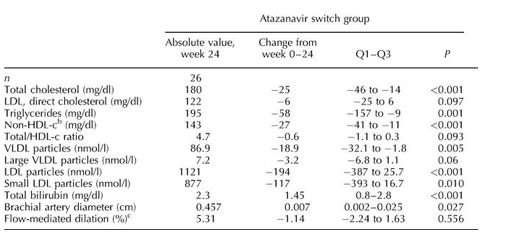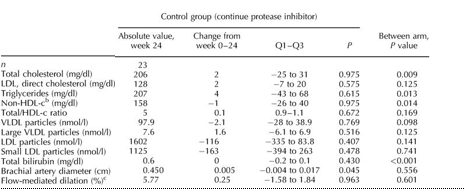| |
Change to atazanavir/ritonavir treatment improves lipids but not endothelial function in patients on stable antiretroviral therapy
|
| |
| |
AIDS:
27 March 2010 - Volume 24 - Issue 6 - p 885-890
"These findings suggests that in mildly dyslipidemic individuals on stable protease inhibitor therapy, switching ART to boosted atazanavir improves lipids but does not affect endothelial function, insulin resistance, or inflammatory markers in the short term.....It is possible that a larger study of longer duration may have detected more differences between the arms.....Also, our patients had normal baseline hsCRP values [20] and markers of insulin and glucose metabolism, so modest lipid improvements may not improve otherwise normal markers of CVD risk such as FMD and hsCRP.....In the A5152s study, the median FMD after 24 weeks of ART was 5.1%, which is relatively normal and very similar to our findings and previous FMD measurements in HIV-infected individuals from the same core imaging laboratory"
Murphy, Robert L; Berzins, Baiba; Zala, Carlos; Fichtenbaum, Carl; Dube, Michael P; Guaraldi, Giovanni; Torriani, Francesca; Belsey, Elizabeth; Mitchell, Carol; Stein, James H; for the SABAR Study Team
aNorthwestern University Center for Global Health, Northwestern University, Chicago, Illinois, USA
bACLIRES Argentina SRL, Buenos Aires, Argentina
cUniversity of Cincinnati, Cincinnati, Ohio, USA
dUniversity of Southern California Keck School of Medicine, Los Angeles, California, USA
eUniversity of Modena and Reggio Emilia, Modena, Italy
fUniversity of California-San Diego, San Diego, California, USA
gSigmaClinical, Daglan, France
hUniversity of Wisconsin School of Medicine and Public Health, Madison, Wisconsin, USA.
Abstract
Objective: Protease inhibitors and other antiretroviral drugs have been associated with dyslipidemia, endothelial dysfunction, and increased cardiovascular disease risk. The protease inhibitor atazanavir has an advantageous lipid profile; we studied its effects on arterial function and other metabolic and inflammatory cardiovascular disease risk factors.
Design: Prospective, randomized, multinational trial in HIV-infected patients receiving stable protease inhibitor-based therapy with plasma HIV RNA less than 500 copies/ml and fasting low-density lipoprotein cholesterol more than 130 mg/dl, or triglycerides more than 200 mg/dl.
Methods: Patients were randomized to continue their current protease inhibitor or switch the protease inhibitor to atazanavir and continue ritonavir if given as a protease inhibitor booster for 24 weeks. Brachial artery flow-mediated dilation, lipoproteins, and inflammatory and metabolic markers were measured at baseline, week 12, and week 24. Median changes within (signed rank test) and between (Wilcoxon test) arms were calculated.
Results: Twenty-six patients switched to atazanavir (all continued on ritonavir); 24 remained on their protease inhibitor regimen. Median CD4 cell count was 499 cells/µl, total cholesterol 204 mg/dl, low-density lipoprotein cholesterol 122 mg/dl, and triglycerides 244 mg/dl. There were no significant changes in flow-mediated dilation after 12 and 24 weeks. At 24 weeks, significant changes in the atazanavir vs. continued protease inhibitor group were observed for total cholesterol (-25 vs. +1.5 mg/dl, P = 0.009), triglycerides (-58 vs. +3.5 mg/dl, P = 0.013), and nonhigh-density lipoprotein cholesterol (-27 vs. -0.5 mg/dl, P = 0.014).
Conclusion: In dyslipidemic individuals with suppressed HIV RNA on stable therapy, changing the protease inhibitor to atazanavir/ritonavir for 24 weeks improved lipids; however, endothelial function, inflammatory, and metabolic markers did not change.
Introduction
Specific antiretroviral therapy (ART) agents and classes of drugs have been associated with an increased risk of subclinical atherosclerosis and cardiovascular disease (CVD) events. Protease inhibitors were the first class of ART agents to be associated with CVD; however, the nucleoside reverse transcriptase inhibitors abacavir and didanosine have also been implicated [1-4]. Increased CVD risk in HIV-infected patients has been associated with ongoing HIV replication, inflammation, dyslipidemia, and direct effects of ART on the vasculature [5-7]. Precise estimation of CVD risk associated with ART in clinical trials has been difficult due to relatively low numbers of hard events and short study durations. Most event data have come from observational studies with inherent limitations and conflicting conclusions.
CVD risk can be predicted from established and emerging risk factors; however, evaluation of arterial function has emerged as a useful tool to evaluate arterial reactivity [8-11]. Abnormal endothelial function has been implicated in early atherosclerosis and development of CVD events [8,9]. Changes in flow-mediated dilation (FMD) with prevention interventions such as antihypertensive and antilipid medications are predictive of CVD risk reduction [12]. In patients meeting the criteria to start ART, endothelial dysfunction is common, and suppressive treatment rapidly improves endothelial function [11]. We prospectively evaluated the effect of atazanavir, a protease inhibitor with a favorable metabolic and lipid profile, on endothelial function in patients on stable suppressive ART [13,14].
Results
Between June 2005 and November 2007, 50 individuals were enrolled: 26 to the atazanavir arm and 24 remained on their current protease inhibitor. All patients completed the study; however, one in the control arm did not complete the week 24 assessments. Baseline characteristics by group are shown in Table 1. Patients were well matched: median age was 43 years, 84% were men, 66% were white, 43% were current smokers, and 30% were on stable lipid-lowering therapy. The median time on ART was 6 years; all patients randomized to atazanavir were already receiving a ritonavir-boosted protease inhibitor and were switched to atazanavir/ritonavir (300 mg/100 mg). The most common protease inhibitor was lopinavir/ritonavir (80%); 28% were receiving abacavir. The median plasma HIV RNA was less than 500 copies/ml and CD4 cell count was 499 cells/µl. Baseline lipid, glucose homeostasis, and inflammatory markers were similar in each group. Median FMD was 4.98% in the atazanavir group and 5.30% in the control group, with similar median baseline brachial artery diameters.
At week 12 (data not shown) and at week 24, no significant difference in FMD was noted from baseline within or between the groups (Table 2); the difference between the means was -0.384 (95% confidence interval -2.080 to 1.312). Brachial artery diameters increased slightly in both groups, but the between-group differences were not significant (P = 0.556). After adjustment for changes in brachial artery diameter, the between-arm differences in FMD remained not significant (P = 0.640). The NTGMD was stable in both arms throughout the study. Patients on an abacavir-containing regimen did not have a significantly different change in FMD or brachial artery diameter as compared with those not receiving abacavir (P = 0.409). In an analysis restricted to patients not on lipid-lowering drugs, the 24-week change in FMD between arms and within arms was not significant (P = 0.970).
At week 24, significant changes in lipid parameters were observed only in the atazanavir arm, including decreases in total cholesterol, triglycerides, and non-HDL-c (all P < 0.001) with significant differences between arms (Table 2). Compared with baseline, the atazanavir arm had significant decreases in very low-density lipoproteins (VLDLs), LDL particles, and small LDL particles; however, between-arms differences were not significant. Significant within and between-arms differences were not seen for any of the metabolic or inflammatory markers evaluated. Plasma HIV RNA remained suppressed and CD4 cell count did not change significantly during the trial. Total bilirubin increased at week 24 in the atazanavir arm only (P < 0.001 within and between arms). No serious adverse events were reported.


Discussion
In treatment-experienced dyslipidemic individuals who switched their protease inhibitor to atazanavir/ritonavir, significant reductions in total cholesterol, triglycerides, and non-HDL-c were observed after 24 weeks. These findings were paralleled by changes in VLDLs, LDLs, and small LDLs. Despite improvements in these atherogenic parameters, we did not observe significant changes in brachial artery FMD, a sensitive measure of endothelial function. Furthermore, we did not observe significant improvements in a wide range of metabolic and inflammatory markers associated with CVD risk. These findings suggests that in mildly dyslipidemic individuals on stable protease inhibitor therapy, switching ART to boosted atazanavir improves lipids but does not affect endothelial function, insulin resistance, or inflammatory markers in the short term.
These finding are not completely unexpected, given the modest degree of dyslipidemia in our patients who had mildly elevated triglycerides, non-HDL-c, and small LDL particles at baseline [19]. Also, our patients had normal baseline hsCRP values [20] and markers of insulin and glucose metabolism, so modest lipid improvements may not improve otherwise normal markers of CVD risk such as FMD and hsCRP. At the end of our study, patients had received approximately 6.5 years of suppressive ART. In the A5152s study, the median FMD after 24 weeks of ART was 5.1%, which is relatively normal and very similar to our findings and previous FMD measurements in HIV-infected individuals from the same core imaging laboratory [10,11]. In a similarly designed study of treatment-experienced patients who were switched to unboosted atazanavir, FMD also did not improve, although serum lipids improved and the 24-week postswitch FMD was only 3.3% [21].
The observed increases in brachial artery diameters over 24 weeks were small, occurred in both arms, and adjustment of FMD comparisons for changes in baseline diameters did not affect them significantly. As all images in each patient were read simultaneously and checked for quality assurance in real time, it cannot be due to temporal drift. A similar phenomenon was seen in Study A5152s, which was not due to an individual site or time of the year (personal communication, James H. Stein). It may represent small changes in sympathetic tone, as patients acclimatize to the test over time.
This study has several limitations. Most of the patients were on lopinavir/ritonavir at entry, and in healthy individuals, lopinavir/ritonavir has a similar effect on endothelial function as unboosted atazanavir despite having different lipid effects [22]. It is possible that a larger study of longer duration may have detected more differences between the arms. The background ART was not controlled and although we attempted to adjust for obvious differences, such as abacavir use, we cannot rule out a possible effect.
| |
| |
| |
|
|
|